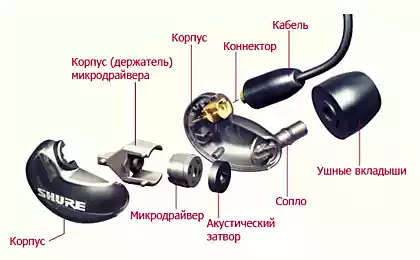2642
What affects the resistance headphones
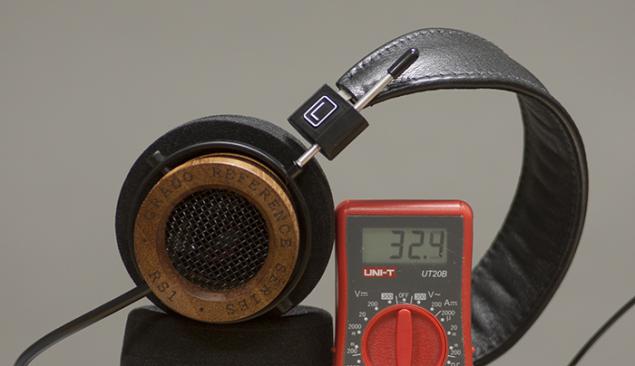
After interview most questions was related characteristic impedance headphones. Consider what impact characteristics and how to treat it. For better absorption of the material we will consistently produce materials, collect questions and comments and move on.
Before examining what and how it affects the resistance of the headphones, take a look at what kind of bird this overseas. And preparing for the fact that there are already two formulas in the standard school physics course. Ie complicated and difficult material.
Resistance headphones is often referred to as the impedance or impedance headphones
From the viewpoint of terms, where a means the only active resistance (resistive) portion under the impedance (impedance) means the combination of resistance and reactance. Remembering school physics course, we know that refers to the reactance, capacitance and inductance.
Finite resistance headphones depends on the frequency on which the measured resistance. The cases often result in resistance or only occasionally value obtained at a frequency of 1 kHz. Unfortunately, rarely stated accompanying parameters and can only guess what impedance headphones have actually.

When it comes to dynamic headphones, the values in the form of 16, 24, 32 ohms, etc. only mean resistance coil speaker and do not account for the resistance of the wire, solder contacts and connectors. In reality, the resistance of headphones usually 1-3 ohms and above is slightly different between the right and left channel. The most conscientious manufacturers honestly indicate that the accuracy of this resistance is 20 or 30% and that's fine (roughly objection to this is only a marketer, no errors on the box can not lead - the 'truth' kills sale).
Low-resistance and high-impedance headphones
Headphones can be divided into low-resistance and high resistance. For co-channel and full-size headphones boundary separating different.
For full-size: nikzkoomnye headphones have less than 100 ohms resistance, and high-impedance above 100 ohms.
For intracanal: low-resistance not exceeding 32 ohm, 32 ohm above - high resistance.
What type of impedance at different headphones?
In-ear monitor

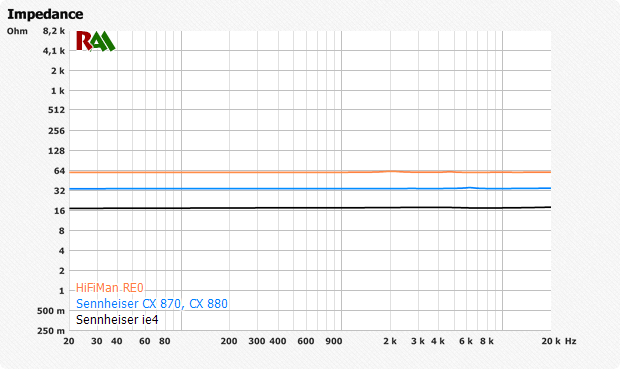
Most dynamic-channel headphones have a flat impedance curve and the value of 16, 24 or 32 ohms have no deviations for frequencies from 20 to 20 kHz.
The graph shown on the horizontal frequency of 20 Hz to 20 kHz. Vertical - resistance (on a logarithmic scale).
Full-size dynamic headphones


In dynamic full-size headphones is often possible to meet the non-uniform impedance curve, with the local climbs at low frequencies and a slight rise in the high frequency region.
Resistance may be 32 ohm without reactive part (conventionally, it 0Hz any universal multimeter measured), but in practice there may be twice as high at certain frequencies.
Non-uniformity (ups) can indicate either resonances, and the design features of the transmitter in the housing headphones. For example, when measuring resistance, frequency and amount of lift can vary on headphones lying freely on the table, or on a mannequin dressed (in this case, the interior of the cushioned headphones).


Some dynamic headphone no significant resonances or deviations. This line is conditional perfect, but the headphones pick up this way is not recommended. In pursuit of improving one property, you have to sacrifice another.
Among the top-class headphones can be found as the impedance curves with minimal deviations and significant. If headphones narrowband visible rise (in the chart above is Grado GS1000 ), the amplifier should be chosen with low output resistance for better control of low frequencies (as is done in the way of corporate amplifier Grado RA1 ).
Isodynamic (orthodinamic) headphones

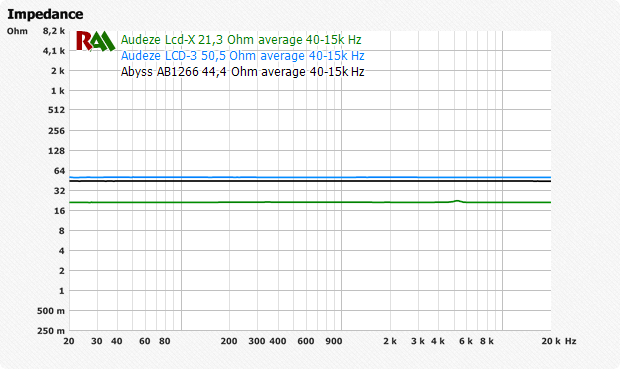
In addition to dynamic emitters widespread now receives isodynamic type emitter (and its similar type - orthodinamic). Such headphones are always a straight line impedance. Isodynamic headphones now produce: Abyss , Audez'e , HiFiMan, Oppo, Fostex. In Soviet times were headphones CBS-5 / m, TDS-7, CBS-15, TDS-16 and CBS-25. Today, models TDS TDS-7 and 15 often do modding.
Formally, this is the ideal load for the amplifier, but in the field of ultra-high frequency (megahertz and gigahertz) in some models of resistance decreases and tends to zero. Such a standard graph deceit not seen with some amplifiers may lead to poor operation.
Intracanal armature headphones


Hardly predictable impedance looks at In-ear monitor with reinforcing emitter
In the low-frequency region is usually typical resistance in the form of 8, 16, 24 or 32 ohms. Above 500 Hz start ups.
If the specified resistance of 100 ohms at 1 kHz - it does not mean that high-impedance headphones, their resistance may be only 16 ohms on the meter readings (at low frequencies).
Hybrid and mnogodrayvernye headphones


It is impossible to predict the impedance curve for mnogodrayvernyh and Hybrid In-ear monitor
General conclusions
Resistance in reality will be like on the box , if the headphones: dynamic-channel or isodynamic Resistance in reality, will be like on the box and have unknown ups , if the headphones: Dynamic false and n olnorazmernye Resistance in reality will not be as on the box , if the headphones: reinforcing or hybrid
If you need to find real resistance in reinforcing or hybrid headphones, you can try to search the results of measurements on the Internet. Methods for measuring the impedance usually give a single result and is not dependent on the stand or measuring complex.
It affects the impedance of headphones?
Headphones Sensitivity
Headphone sensitivity is usually given to the power that allows for just two features: headphone supplied voltage and current. This is a handy feature for ultimate theorists and very complicated for practical use by end users.
For the average consumer it is logical to imagine that the "sensitivity = the volume." With the columns is broken; always indicated resistance value column as a 4 or 8 ohms, and likewise indicates the power amplifier. Difficult to get confused.
But if only two columns typical resistances 4 and 8 ohms and each power amplifier is given by two types of resistance, then the impedances headphone about 11: 8, 16, 24, 32, 64, 128, 256, 320, 608, etc. it dry.
As a result, the consumer picks up the headphones with different resistance and naively believes that the sensitivity it may have something to compare.
To link "sensitivity = volume" was applied to the headphones, it is necessary to express the sensitivity to stress, not power (as it does Sennheiser). But most manufacturers do not indicate , the units given sensitivity.
That is why "everybody knows" - that high-impedance headphones quiet and low-impedance headphones - loud. And naively believe that high impedance headphones need a "power amplifier", and for low-impedance headphones and crummy enough smartphone. And although in reality it is not so, because of the extremely unfortunate terms of GOST standards and AES formed some "concepts", contrary to the laws of physics, but the vulgar language quite accurately describes the results, such as: "For high impedance headphones need a powerful amplifier." Physically illiterate, but "everything is clear to everyone».
Touch on this subject more deeply (carefully transition to the formula of the school, begin to strain the brain!)
The output of the amplifier, we do not directly handle the power and voltage level only. Depending on the resistance level obtained headphone current consumed headphones which in turn determines the final power level.
It is very important to understand, because without changing the output voltage of the amplifier, we can not physically able to separately increase the current level and thereby increase the power level.
U = I * R , where
U - voltage on the output of the amplifier, in
I - current, A
R - resistance headphones, Ohm
W = I * U , where
W - output power of the amplifier, W
U - voltage on the output of the amplifier, in
I - current, A
If you do not boil the brains of two simple formulas, you can move on.
An excellent example is the headphones Beyerdynamic DT 770 series with different resistance, 32, 80, 250 and 600 ohms (some models taken out of production).
All headphones uniform sensitivity of 96 dB / mW, which means that if you drive headphones exactly 1 mW, the sound pressure level is equal to 96 dB SPL.
At 1 mW for the different models we have to apply different ratios of voltage and current:
Resistance, Ohm 32 80 250 600 The voltage at 1 mW, mV 179 283 500 775 Current at 1 mW mA 5 6 3, 5 2 1 3 Ie. low impedance models 32 ohms is required is the low voltage, but the highest value of the current level
high-resistance model on the contrary need the high voltage but low current level
Go back to the fact that the output of the amplifier, we are putting stress level. Smartphone is about 200-300 mV. Physically seen to limit the volume of high impedance headphones, which makes high-impedance headphones automatically "quiet." And we actually do not have enough not "power" amplifier and voltage corny.
But if all manufacturers indicate sensitivity to stress, then it would have been very clear:
Resistance, Ohm 32 80 250 600 Sensitivity dB / mW 96 96 96 96 < / The sensitivity, dB / V 111 107 b > 102 98 As you can see from the table, the difference in volume between the models with a sensitivity of 96 dB / mW for 32 and 600 ohms is 13 dB.
According to sensitivity to stress, we see a direct relationship with the volume.
Key findings h4>
The sensitivity is necessary to look not to the power, and to the stress. Just so you can compare headphones' volume » The lower the resistance, the higher the sensitivity headphones. The higher the resistance, the lower the sensitivity, respectively.And now, when we see that with different resistance from the amplifier require different levels of voltage and current, we can move on to other dependencies that are affected by the resistance of the headphones.
Hours player or smartphone
The higher the resistance of the headphones - the longer it will operate the player or smart phone without recharging, as high-impedance headphones consume less power.

If you have a smartphone quiet - something real choice in headphones with different resistances do not have sufficient sensitivity to be only low-impedance headphones.
However, if your smartphone or player "powerful" way (ie providing the voltage level above 200-300 mV), you can choose between a highly sensitive low-impedance headphones, and less sensitive to higher resistance. In this case, the output equal volume replacement 16 ohm 32 ohm reduce current consumption by one third. Against the background of the energy consumption processor and other chips, smart phone or player an opportunity to work is certainly not one-third longer, and the fourth or fifth. For example the player Colorfly C4 Pro runtime varies from 5 to 8 hours (5 hours with M-Audio IE40 with strong drawdown at high frequencies and 8 hours of high-impedance headphones).
By "strong" players, such as iHiFi or Hidisz, should pick up headphones with great resistance, and check the adequacy of the volume, in-store "on the spot". In stores Soundpal all you can listen to and try to purchase.
Returning to the charts with examples of resistance:
Odnodrayvernye armature headphones in reality have higher average resistance and with them a smartphone or a player can run longer on a single charge. Mnogodrayvernye headphones may have a smaller average resistance on the contrary, and with them a smartphone or a player can work less time without recharging.
The sound quality
"Everyone knows" that "high-impedance headphones sound quality." But in this case, not the headphones sound qualitative and amplifier gives less current and result in less distortion at the amplifier. But this rule - not a dogma, if the amplifier will work with a voltage level that exceeds its normal mode, the source of distortion will not overload current and voltage.
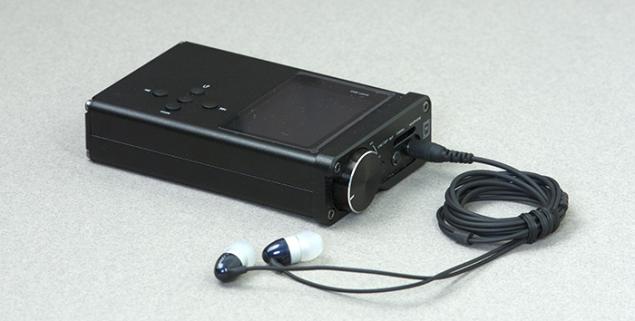
This is a great secret odnodrayvernyh reinforcing quality headphones (such as Grado GR8 a > and GR10 , models Etymotic, senior Klipsh), where, thanks to the rise in the region of the upper middle and high frequencies is obtained high-quality sound with the players and phones, where the full horror with low impedance dynamic headphones.
AFC headphones
If the amplifier does not have zero resistance, the final response will vary depending on the impedance curve as headphone and amplifier. Consider this in detail in a future release, the more that is required to consider what effect the output impedance (impedance) of the amplifier.
How to measure the resistance of headphones?
For a detailed schedule need specialized software and stand. But to determine the magnitude of resistance (in the lowest frequencies) enough budget multimeter cost from 200 rubles.
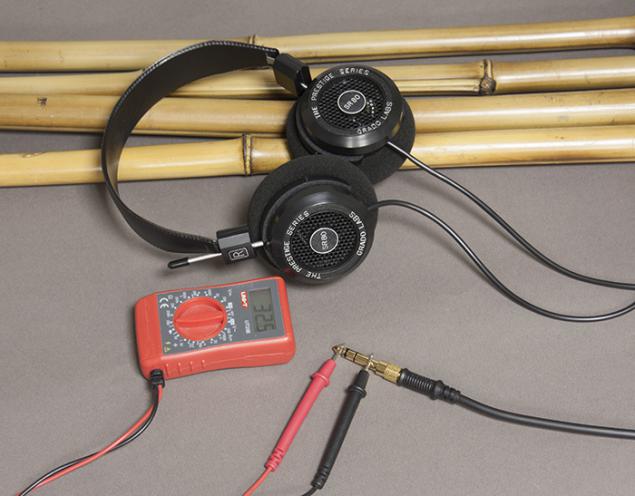
It is quite normal when buying headphones to check the resistance of the right and left channel, the difference should not exceed 2.3 ohms between channels in most cases.
Source: geektimes.ru/company/soundpal/blog/243447/




